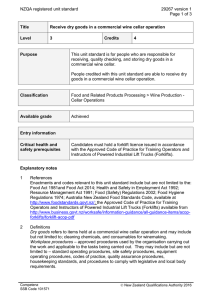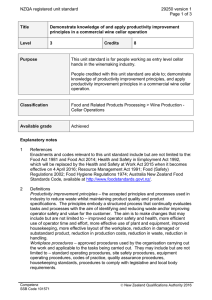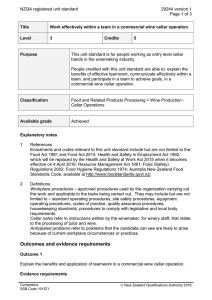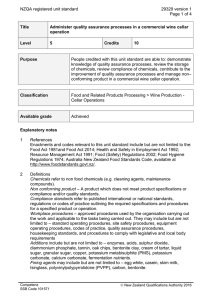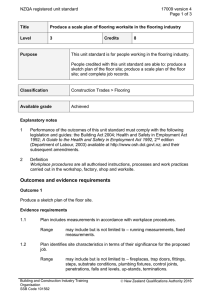NZQA registered unit standard 29253 version 1 Page 1 of 4
advertisement
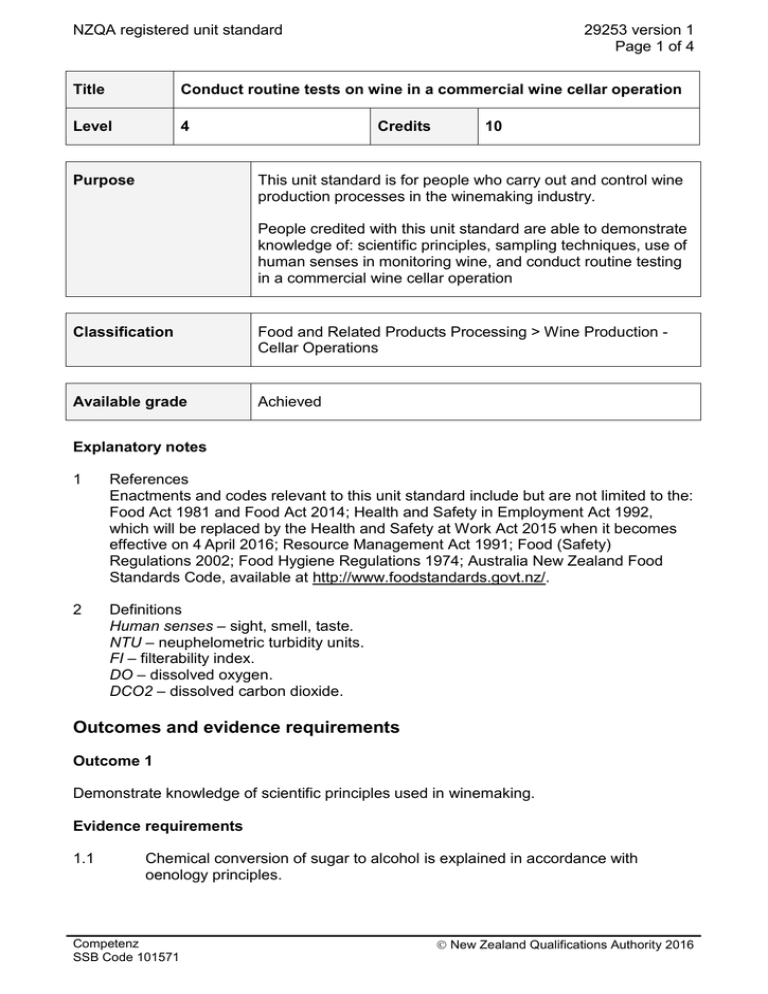
NZQA registered unit standard 29253 version 1 Page 1 of 4 Title Conduct routine tests on wine in a commercial wine cellar operation Level 4 Purpose Credits 10 This unit standard is for people who carry out and control wine production processes in the winemaking industry. People credited with this unit standard are able to demonstrate knowledge of: scientific principles, sampling techniques, use of human senses in monitoring wine, and conduct routine testing in a commercial wine cellar operation Classification Food and Related Products Processing > Wine Production Cellar Operations Available grade Achieved Explanatory notes 1 References Enactments and codes relevant to this unit standard include but are not limited to the: Food Act 1981 and Food Act 2014; Health and Safety in Employment Act 1992, which will be replaced by the Health and Safety at Work Act 2015 when it becomes effective on 4 April 2016; Resource Management Act 1991; Food (Safety) Regulations 2002; Food Hygiene Regulations 1974; Australia New Zealand Food Standards Code, available at http://www.foodstandards.govt.nz/. 2 Definitions Human senses – sight, smell, taste. NTU – neuphelometric turbidity units. FI – filterability index. DO – dissolved oxygen. DCO2 – dissolved carbon dioxide. Outcomes and evidence requirements Outcome 1 Demonstrate knowledge of scientific principles used in winemaking. Evidence requirements 1.1 Chemical conversion of sugar to alcohol is explained in accordance with oenology principles. Competenz SSB Code 101571 New Zealand Qualifications Authority 2016 NZQA registered unit standard 1.2 The purpose and scientific principles of routine tests used in winemaking are explained. Range 1.3 29253 version 1 Page 2 of 4 routine tests – sulphur levels, residual sugar, alcohol level, brix hydrometer reading, titratable acidity, dissolved oxygen, dissolved carbon dioxide, pH, NTU, filterability index, nominal turbidity. Standards or specifications of test methods are explained in terms of quality, health, safety, hygiene or labelling requirements. Outcome 2 Demonstrate knowledge of sampling techniques used in commercial wine cellar operations. Evidence requirements 2.1 The objectives of sample collection are described in accordance with scientific principles. 2.2 Sample collection methods used in winemaking are described in accordance with workplace procedures. 2.3 Measures taken to ensure the integrity of samples during and after collection are explained in accordance with workplace procedures. 2.4 Consequences of poor sampling on the quality of information used in winemaking are explained. Outcome 3 Demonstrate knowledge of the use of human senses in monitoring winemaking operations. Evidence requirements 3.1 Use of human senses to detect wine faults is described in accordance with oenology principles. Range 3.2 wine faults – hydrogen sulphide, oxidation, films, volatile acidity, sulphur dioxide, presence of brettanomyces. Use of the sense of smell as a tool in monitoring winemaking operations is explained in terms of desirable and undesirable aromas. Range evidence is required of two desirable and two undesirable. Outcome 4 Conduct routine tests in a commercial wine cellar operation. Competenz SSB Code 101571 New Zealand Qualifications Authority 2016 NZQA registered unit standard Range 29253 version 1 Page 3 of 4 routine tests – sulphur levels, residual sugar, alcohol level, titratable acidity, dissolved oxygen, dissolved carbon dioxide, pH, NTU, brix hydrometer reading, FI. Evidence requirements 4.1 Safe work practices associated with sampling, selecting and applying routine tests in a commercial wine cellar operation are identified and used in accordance with workplace procedures. practices may include but are not limited to – isolation procedures, lock outs, emergency stops, machine guarding, wearing appropriate safety equipment. Range 4.2 Samples are gathered and prepared for routine tests in accordance with workplace procedures. 4.3 Equipment for routine tests is cleaned, assembled, and checked in accordance with workplace procedures. 4.4 Routine tests are carried out and results are recorded and reported in accordance with workplace procedures. Planned review date 31 December 2019 Status information and last date for assessment for superseded versions Process Version Date Last Date for Assessment Registration 1 19 November 2015 N/A Consent and Moderation Requirements (CMR) reference 0013 This CMR can be accessed at http://www.nzqa.govt.nz/framework/search/index.do. Please note Providers must be granted consent to assess against standards (accredited) by NZQA, before they can report credits from assessment against unit standards or deliver courses of study leading to that assessment. Industry Training Organisations must be granted consent to assess against standards by NZQA before they can register credits from assessment against unit standards. Providers and Industry Training Organisations, which have been granted consent and which are assessing against unit standards must engage with the moderation system that applies to those standards. Requirements for consent to assess and an outline of the moderation system that applies to this standard are outlined in the CMRs. The CMR also includes useful information about special requirements for organisations wishing to develop education and training Competenz SSB Code 101571 New Zealand Qualifications Authority 2016 NZQA registered unit standard 29253 version 1 Page 4 of 4 programmes, such as minimum qualifications for tutors and assessors, and special resource requirements. Comments on this unit standard Please contact Competenz at qualifications@competenz.org.nz if you wish to suggest changes to the content of this unit standard. Competenz SSB Code 101571 New Zealand Qualifications Authority 2016
